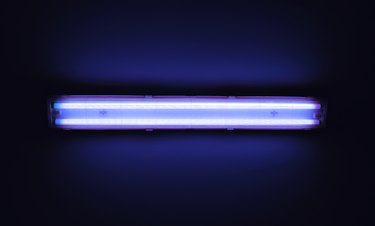
Compared with incandescent lights, fluorescent bulbs are relatively inexpensive, longer lasting and use less energy. For these reasons, fluorescent tubes are now widespread. They're currently used in industrial, commercial and public facilities.
There are several types of fluorescent lights. The most common straight tube types are T5, T8 and T12, available in lengths up to eight feet. All fluorescent bulbs require a ballast to operate, while older models require a starter as well.
Video of the Day
Video of the Day
Classification
The letter T is used in front of the number to show that the fluorescent light is a tube and not a bulb like traditional lights are. Following the letter is a number representing the diameter of the bulb measured in fractions of an inch. Fluorescent bulb widths are measured in eighths of an inch. For example, a T5 bulb is five-eighths of an inch wide, a T8 bulb is 1 inch wide or eight-eights wide and a T12 is 1-1/2 inches or 12/8ths in diameter.
T12 Type
Since their conception in the 1930s, fluorescent T12 bulbs were the choice of building contractors. The low cost and life span of 20,000 hours far surpassed incandescent bulbs. However, because of its less efficient magnetic ballast and larger bulb size, it has lost popularity to the T8 electronic ballast type. T12 and T8 bulbs are available in the same lengths, however, ordinary T12 bulbs do not operate properly with an electronic ballast and vice versa. Magnetic ballasts were banned July of 2010, but left over inventory and other T12 bulbs were still on the market.
T8 Type
Fluorescent T8 bulbs have continued growing in popularity since they were brought to the United States in 1981 and have now become the standard in building construction. The T8 bulb's lifetime can exceed that of the T12, while using less energy. Additionally, the T8 uses an electronic ballast that is more energy efficient than the T12 magnetic type. With the T8 ballast using solid-state circuitry to operate, it does not make a loud humming sound or cause light flickering that's commonly found with the T12 magnetic ballast.
T5 Type
The T5 fluorescent bulb is only similar to the the T8 in that it uses an electronic ballast. However the cost of T5 bulbs, especially high output types, is significantly higher than T8 and T12 bulbs. T5 bulbs are also shorter and do not fit standard fixtures. For example, a typical T5 bulb is 46 inches long rather than the 48 inches (4 foot) of T8 and T12 bulbs. Conversion kits are available, with a ballast, allowing T5 bulbs to fit T8 and T12 fixtures. T5 bulbs save money over time because of a longer lifespan while producing more light with less wattage. The T5 also maintains maximum light output for most of the bulb's lifetime.
Future Technology
T5, T8 and T12 LED (light emitting diode) replacement tubes currently on the market fit into existing fluorescent fixtures. The technology of LEDs is different from fluorescent bulbs and comes with its own advantages and disadvantages. The biggest factor being price since they cost 10 times more than fluorescent tubes. They do however last up to 50,000 hours, use less power, operate without a ballast and do not contain hazardous mercury that fluorescent bulbs use. Like any new product, cost reduction will depend on improved technology and consumer demand.